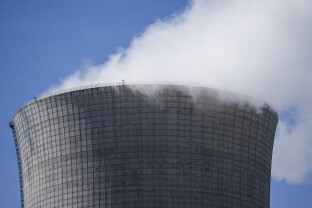There’s an obvious solution to the compounding energy problems in the United States, but even overwhelming bipartisan excitement can’t overcome one critical obstacle: States say it’s just too expensive.
Nuclear power is a source of nearly unlimited, carbon-free, dependable energy that could significantly alleviate the stress on the United States’ electrical grid and any subsequent spikes in electricity prices. This year, Congress passed nuclear reform with near unanimity, with only two senators and 13 House members in opposition.
Yet state public utility commissioners are warning that without even more significant federal investment, new nuclear plants are simply out of reach — or run the risk of seriously increasing consumers’ costs.
“I’m urging commissioner colleagues from around the country to use great caution when considering nuclear,” Tim Echols, one of Georgia’s public service commissioners, said. Echols is an unlikely naysayer; he’s a fan of nuclear power who helped ensure that the first new plant in the country in more than 20 years made it over the finish line in Georgia in 2023.
Plant Vogtle will bring stable, dependable, nearly unlimited power to the state. Still, Georgians will have to pay significantly more for electricity because the project went billions of dollars over budget.
“They are all somewhat aware of Vogtle’s issues here in Georgia, and I want them to be successful in their efforts,” Echols said.
Echols and fellow state commissioner Nick Myers in Arizona have been arguing in private meetings and in editorials for the energy community that the Department of Energy and Congress should embrace the idea of a federal backstop to cover the cost overruns for future new nuclear plants. Echols wants the government to allocate $50 billion of IRA funding for five reactors instead of passing the prices along in the electricity bills of the communities served by the nuclear plant.
“Regulators don’t want to pass the costs on to the ratepayers,” Myers said.
Biden’s Department of Energy disagrees that the government should backstop overrunning costs, as do conservatives in the energy space.
Secretary of Energy Jennifer Granholm, who has hosted many of the people worried about costs to talk through the issues in her office, according to Brian Smith, the Department of Energy’s deputy assistant secretary for nuclear reactor, explicitly challenged the CEO of one utility about the cost problem at a June conference.
“That’s hard to hear because we’ve just put billions and billions and billions on the table,” she said at the conference. “I don’t know what the delta is between what you think is necessary and what it would actually take to build up.”
Smith himself attributes budget problems to poor planning.
“It doesn’t do us any good if the project plans being put together are built on a rosy assessment of every one of the thousand things,” he said, acknowledging that the DOE understands the pressing importance of the cost problem. “I think everyone needs to recognize that some of this is hard, and some of this will be expensive.”
The Inflation Reduction Act, which Biden signed in 2022, provides production incentives for new nuclear plants and makes nuclear eligible for zero-emissions tax credits going into effect next year. The Advance Act, which Biden signed in July, gives the Department of Energy the power to set up prize competitions for nuclear plants.
The administration has also prioritized nuclear significantly in the last year with a litany of efforts, including: offering a loan to help a nuclear plant in Michigan reopen; helping extend the life of the Diablo Canyon plant in California; and advancing Department of Defense projects to establish advanced nuclear power on military bases.
There’s been renewed interest from utilities, tech companies, industry and states, as well. The Department of Energy sees nuclear as an integral requirement for clean energy goals. States like Arizona and Wyoming are among those hoping it will help coal communities facing plant shutdowns; and many Republicans in Congress are worried that without it, the U.S. will never be able to pursue energy independence from China. (China approved five new nuclear plants in August alone.)
“To achieve the kinds of clean energy we’re talking about putting on the grid, you simply don’t get there without nuclear,” Smith said.
Still, no significant new nuclear power is planned in the U.S. beyond demonstration projects. All of the rare political progress keeps running into the reality that new nuclear plants are so much more expensive to build than other plants like gas or renewables with batteries attached.
In addition to a federal backstop for funding, Myers envisions that the Department of Defense could invest in new advanced nuclear reactors until they reach a reasonable price, like the military did with submarines. Alternatively, tech companies with sustainable development goals could also reach agreements with independent power producers to help fund new projects.
“There isn’t a regulator in the country that is keen on being the R & D guinea pig, paying the cost for that,” Myers said. He’s pushing for the idea of cost-overrun insurance alongside Echols because he wants to see new nuclear come online, just like many utility commissioners across the country.
The Department of Energy will soon make about $900 million available in funding for up to two new advanced reactors, and Smith is encouraging utilities and industry players to work together to find creative solutions for new projects in applications for that funding. The DOE recently hosted industry leaders, in part to discuss the upcoming project.
“What we’re encouraging and trying to get out of this solicitation is not just one reactor, it’s an order book,” Smith said. “An order book of deployments that presents an opportunity for you, industry, to ride that cost curve down.”
Nuclear advocates outside the administration, like Devin Hartman, the director of energy and environmental policy at center-right think tank R Street, are equally critical of the backstop idea but see reducing regulation as far more important than federal incentives. “The economics of new nuclear don’t need to be as harsh as they actually are,” Hartman said. “The Nuclear Regulatory Commission is effectively holding back innovation.”
But Hartman acknowledged that even reform at the NRC won’t bring the cost down to parity with other energy sources. For Hartman, the question is: How much is the U.S. willing to pay for clean energy?
Individual states make the final decision on those kinds of costs, and the answer may just be not enough.
Colorado, a state with serious renewable energy commitments, sees no place for nuclear unless the costs come down significantly. And at the nuclear meetings for the national association of public service commissioners like Echols, every state is still worried about the same thing: cost.
“I know the backstop idea is a last resort, but without it, I believe states will continue to delay signing agreements,” Echols said.
—
Anna Kramer is a reporter at NOTUS.
Sign in
Log into your free account with your email. Don’t have one?
Check your email for a one-time code.
We sent a 4-digit code to . Enter the pin to confirm your account.
New code will be available in 1:00
Let’s try this again.
We encountered an error with the passcode sent to . Please reenter your email.


